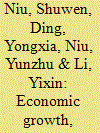|
|
|
Sort Order |
|
|
|
Items / Page
|
|
|
|
|
|
|
| Srl | Item |
| 1 |
ID:
103344


|
|
|
|
|
| Publication |
2011.
|
| Summary/Abstract |
This study was conducted to evaluate the causality between energy consumption, GDP growth and carbon emissions for eight Asia-Pacific countries from 1971 to 2005 using the panel data. The results indicate that there are long-run equilibrium relationships between these variables. Additionally, causality from energy consumption to CO2 emissions was observed generally, but there were some opposite relationships also. Parameter estimations of the panel data model indicate that there are great differences in the carbon emissions, the efficiencies of energy use, carbon emissions of unit GDP and unit energy consumption between developed and developing countries. The base carbon emissions, per capita energy consumption and efficiency of energy use in developing countries are far lower than in developed countries; however, the CO2 emissions per unit of energy use is higher. Although developing countries may reduce their CO2 emission per unit energy use, total energy consumption will rise rapidly with economic development. Thus, developing countries must determine how to undergo economic growth while conserving energy and reducing emissions. To respond to global climate change, it is necessary to develop innovative technology for energy use, transform the energy structure and conduct the clean development mechanism.
|
|
|
|
|
|
|
|
|
|
|
|
|
|
|
|
| 2 |
ID:
113006


|
|
|
|
|
| Publication |
2012.
|
| Summary/Abstract |
The present paper calculates 35 industrial sectors' similarity matrices for the period of 1997-2008 using China's input-output tables for 1997, 2002 and 2007, and uses these to measure inter-industry technology spillover to analyze the spillover effects on industrial sectors' labor productivity. The empirical analysis shows that inter-industry technology spillover has a significant positive effect on the labor productivity of each industry. The elasticity of productivity effects of inter-industry technology spillover is not only larger than that of direct R&D input, but also increases over time. We group the industries into four major categories and find that the inter-industry technology spillover effect within the categories is, on average, greater than that between the four categories, indicating that technology spillover occurs more easily between similar industries. This research shows that the interindustry technology spillover effect in China has begun to increase, and the government should take advantage of this effect.
|
|
|
|
|
|
|
|
|
|
|
|
|
|
|
|
|
|
|
|
|